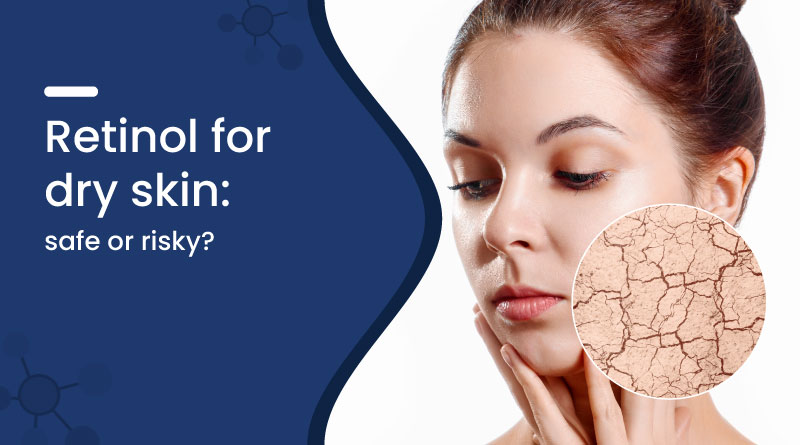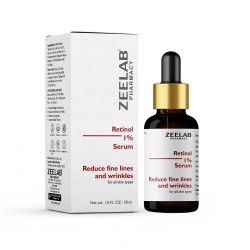Retinol for Dry Skin – Benefits, Tips & How to Use Safely


If you have dry skin, you may be wondering: Is retinol safe for dry skin or does it make things worse? Retinol is one of the most powerful skincare ingredients for anti-aging and acne treatment, but for people with dry or sensitive skin, it can be tricky. In this blog, we’ll break down how retinol affects dry skin, how to use it safely, and which product might work best for you.
Can Retinol Be Used on Dry Skin?
Yes, retinol suits dry skin if used gently—it may cause dryness. However, this process can lead to peeling, irritation, and flaking—especially if your skin is already dry or sensitive.
To make it work for dry skin, dermatologists recommend:
- Using a low concentration (0.1% to 0.3%)
- Applying it only 2–3 times a week
- Layering with a moisturizer to reduce dryness
- Avoiding other harsh actives like AHAs/BHAs
How Does Retinol Affect Dry Skin Over Time?
In the short term, retinol may cause dryness, redness, or tightness. But in the long run, retinol can actually improve dry skin by:
- Strengthening the skin barrier
- Boosting natural hydration levels
- Increasing cell turnover for a smoother, brighter complexion
Just remember: consistency + patience = results. It might take 4–6 weeks for your skin to adjust.
Which Retinol Ingredients Are Best for Dry Skin?
When choosing a retinol product for dry skin, look for formulas that include:
- Hyaluronic Acid – deeply hydrates and prevents peeling
- Vitamin E – soothes and protects the skin barrier
- Niacinamide – improves skin texture and calms inflammation
- Panthenol (Vitamin B5) – acts as a hydration matrix to lock in moisture
These ingredients help buffer the retinol effect, reducing the risk of irritation.
Which is the Best Retinol for Dry Skin in India?
If you're looking for a gentle, effective option tailored to Indian skin, Zeelab’s Retinol Serum is a top pick.
| Product Name | Uses |
|---|---|
| Zeelab Retinol Serum | Reduces fine lines, brightens, and hydrates skin |
This formula is ideal for first-time users and those with dry skin due to its balanced ingredients.
How to Safely Use Retinol on Dry Skin?
Here’s a simple 5-step routine to use retinol safely if you have dry skin:
- Cleanse with a gentle, non-foaming cleanser
- Use moisturizer before or after retinol to buffer
- Use retinol only at night (2–3 times/week)
- Always apply sunscreen in the morning
- Avoid mixing with Vitamin C, AHAs, or exfoliants initially
Pro Tip: Patch test before full use. And if irritation continues, reduce frequency or consult a dermatologist.
What Are the Side Effects of Retinol for Dry Skin?
While retinol is generally safe, some mild side effects are common, especially in the beginning:
- Dryness and flaking
- Redness or irritation
- Tingling or mild burning sensation
These are usually temporary and improve as the skin adjusts. To manage this, hydration and slow introduction are key.
Frequently Asked Questions
Q. Can retinol make dry skin worse?
A. Yes, initially it can increase dryness. But with proper usage and moisturizing, it becomes manageable.
Q. Should I use moisturizer with retinol?
A. Absolutely. Always use a good moisturizer to prevent flaking and irritation.
Q. What time should I apply retinol on dry skin?
A. Use at night after cleansing.
Q. Can I use retinol every day if I have dry skin?
A. No. Start with 2–3 times a week and gradually build up if your skin tolerates it.
Q. When to start retinol for dry skin?
A. You can start in your mid-20s for preventive care, but always start with a low-strength formula.
Conclusion: Should You Use Retinol for Dry Skin?
Retinol for dry skin is safe when used correctly. The key lies in choosing the right formulation, building tolerance gradually, and keeping your skin hydrated. If you’re looking for a trusted, affordable option, Zeelab Retinol Serum delivers results with minimal irritation.
Whether you’re targeting fine lines, pigmentation, or dullness, this breakout-safe formula offers a balanced approach, even for dry skin types.
Recent Blogs
Disclaimer : Zeelab Pharmacy provides health information for knowledge only. Do not self-medicate. Always consult a qualified doctor before starting, stopping, or changing any medicine or treatment.

















 Added!
Added!